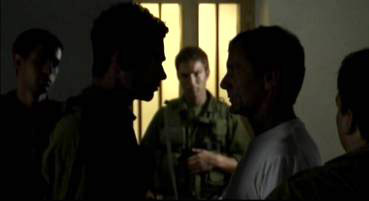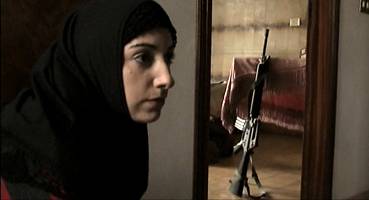|
"This
house is occupied. I ask you to go and never come back."
Anyone making a feature film on something of the scale, complexity, and opinion-dividing
potential of the Palestinian-Israeli conflict has their
work cut out for them. Even the most exhaustive documentary
is going to look light on detail, and dramatic works have
a tightrope of political opinion to walk if they are to
avoid heated censure from one or both sides of the debate and
be dismissed by either one as propagandist. Part
of the problem is that almost any story set in times of
conflict is inevitably going to present one side in a more
favourable light, but director Saverio Costanzo's Private arrives on the back of festival
prize wins and positive reviews that talk of the film's
remarkably even-handed approach to its situation and characters.
Whether you agree with that assessment may well be influenced
on your own political standpoint, if indeed you have one
in regard to this particular hot potato. Certainly, with
the Israelis as the invading force and the Palestinians
as oppressed victims, even humanising the occupying soldiers
is going to have only a partial balancing effect.
Based
on real events,* the story concerns a Palestinian family
who are living close to a settlement in the
disputed and unstable Latrun no-man's land. All too aware
of the danger of their predicament, the mother wants them
to leave, but the father proudly refuses to be driven from his home and insists that they stand their
ground. One night,
their house is invaded by Israeli soldiers, who inform
that family in no uncertain terms that the house is now
under Israeli rule. It's occupants are subsequently confined to
one small downstairs room, the upstairs being strictly
off-limits, the kitchen area to be accessed only with
the soldiers' permission. Anyone who even attempts to break
these rules, they are informed, will be dealt with accordingly.

Working
both as a microcosm of the conflict at large and an attempt
to put a human face on a situation that has become long since buried under
news reports and rhetoric, the film kicks off as a family
drama, but with the arrival of the soldiers the tension
is cranked up and the politics of the situation are pushed to the fore.
Herein lies the film's bite. The
house is situated in the Latrun region, which the Palestinians claim is part of the West Bank,
something the Israelis have always disputed. It
remains an area of constant and sometimes physical conflict
between the two sides. As the property is taken over,
the Israeli commander declares that it is now Israeli
territory, effectively displacing its occupants and confining
them to small area that they can still regard as home.
You only need a passing knowledge of the the wider issue
to appreciate the parallels with what's taking place outside
of the house – indeed,
the initial disagreements within the family unit are driven
almost exclusively by the politics of their location.
Once the occupying soldiers have settled
in, the father's determination to stand his ground
hardens, while the mother's reaction is to propose active
resistance. As the father's resolve is increasingly tested,
the children develop their own set of responses, which are also representative of the conflict at large – the older daughter becomes a
spy, sneaking upstairs and hiding in a wardrobe to eavesdrop
on the soldiers, while the eldest son discovers a live grenade and takes the first step towards becoming
a resistance fighter. With all communication with the
family conducted in a neutral language (English) by the
conflict-hardened commander, it is the daughter, listening
in from her hiding place upstairs, who is first to see the human face
behind the enemy uniforms, as the soldiers enthusiastically
cheer their football team (on a TV raided from the living
room in which the family is confined), pass the time playing
musical instruments, and are repeatedly scolded by the officer in charge. Later, when the commander threatens to follow
through on his threat to punish anyone who breaks his
rules, his own soldiers clearly regard his actions as
inappropriate and extreme.
If
the film is intriguing viewing on this level alone, it
proves genuinely compelling when the conflict explodes,
most notably when an undefined exchange of gunfire has
the entire family scrabbling urgently in the dark for
cover, a sequence that is both frightening and chillingly
authentic. Shot handheld on digital video, the whole film
has a documentary feel to it, but never more so than in
this scene, where the panic and confusion of the characters
is reflected in the frantic camerawork and almost complete
lack of light, the soundtrack a blaze of urgent shouts
and close-quarters gunfire. Only after the film is over
do you realise that we never saw a shot fired in any of
these sequences, and that the effect was achieved purely through suggestion and sound. Never, for one second, does it feel
like a concession to the presumably minute budget.

Occasionally,
the plot developments and political allegory are a tad overstated (the small child who follows his sister upstairs,
the symbolic rebuilding of the greenhouse), but are still rarely followed through to the expected conclusions.
Perhaps the biggest problem, at least for Western audiences,
is an ending that not only lands on us almost out of
nowhere, but is accompanied by an English language song
that feels musically so wrong for this location
and situation, and whose lyrics all too obviously spell
out a message that has been handled cinematically with far more subtlety.
For
the most part, though, Private is a gripping
and thought-provoking work that deserves to be seen
and talked about. That it achieves even a degree of balance
is an admirable achievement and should make it accessible
to those on both sides of the political divide, helped
enormously by the use of both Israeli and Palestinian
actors, all of whom are completely convincing and were here able to work together here for a common cause.
Enough said.
As
mentioned above, the film was shot on digital video with
minimal lighting and some visible practicals (lamps, torches,
matches, etc.). The result is an image that varies wildly
in quality, being quite strong when outside in the day,
but extremely grainy when dealing with unlit night-time
interiors. This will prove a barrier in itself for a small
portion of the film's potential audience for whom pristine
35mm is the only way to go (especially now they have DVD
players and big TVs), but digital video has its own unique
aesthetic that is highly appropriate for Costanzo's movie,
visually aligning it with with the news footage that is
our main source of information on the conflict in the
West and lending it by association an urgent authenticity.
Within these restrictions the transfer is otherwise as
solid as you could expect, with decent contrast and black
levels and solid enough colour, though it is inevitably
drained in the darker scenes.
The
sound may be Dolby 2.0 stereo, but has been impressive
recorded and mixed, the gunfire in the above discussed
scene having an alarming 'just outside the door' quality
that really adds to the sense of danger. That said, I
couldn't help thinking that this would have been genuinely
terrifying with a more inclusive 5.1 track, when you would
feel surrounded by the gunfire and every bit as trapped
as the family.
Behind
the Scenes – Not Only for Piece of Land (11:10) is a rather rough-looking and structureless collage
of non-anamorphic widescreen footage from the making of
the film, interesting in the main for seeing the actors
in sometimes animated debate over the very issues the
film is attempting to explore. Lead player Mohammed Bakri
(who plays the father) in particular is very vocal on
this, though a telling moment has the young actor playing
his son asked "How do the Israeli soldiers make you
feel?" to which he responds simply, "Angry."
Even the youngest children on set already have very clear
views about the politics of the situation.
Saverio
Costanzo Q&A (34:21) is a one-shot (edited down and broken up with
question title cards) recording of a Q&A session held
with the director after a screening of the film at London's
ICA Cinema in March 2005. This is a fascinating inclusion
in which Costanzo covers in some detail his approach
to the film and the process of its construction, one that interestingly kicks
off with him explaining his decision
to use the Roger Waters track at the end of the film.
The debate hots up a bit when a few of the audience disagree
with his decision to humanise the Israeli soldiers. He
also talks about working with Mohammed Bakri and provides
some interesting background to the real story on which
the film was based. This is 4:3 DV.
Finally
the theatrical trailer (1:43)
sells the film rather well and is presented anamorphic
1.85:1.
It
is often the case that it takes an outsider to see things
with a more objective viewpoint, and that is certainly
the case here with Italian director Saverio Costanzo's
first film. That said, it remains a persuasively political
work, decrying the treatment of Palestinian families by
Israeli forces, yet at the same time calling for an approach
that involves both parties, concluding with the warning
that the situation as it stands is self-perpetuating and
potentially without end. Despite winning prizes at a number
of international festivals, the film has not attracted
the attention it deserves in the UK. It should be seen,
and now it is available on DVD there's no excuse not to
hunt it out and give it a look.
*
The house in question was occupied in 1992 and remains
so to this day.
|